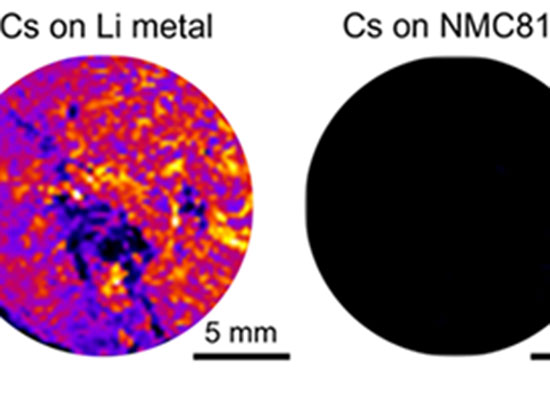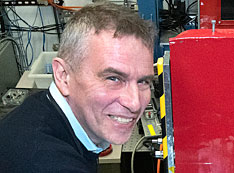X-ray Powder Diffraction
Science Highlights

Improving Next Gen Solid-State Lithium Batteries with Halide Separation
Wednesday, August 13, 2025
Scientists discover technique that could lead to safer, cost-effective, longer-lasting solid-state batteries.

A New Route to Highly Complex, Stable Metal-Organic Frameworks
Wednesday, April 9, 2025
Compared to conventional synthesis methods that takes hours, researchers synthesize materials within milliseconds.

Brookhaven's Top 10 Discoveries of 2024
Thursday, December 19, 2024
Brookhaven Lab celebrates a year of scientific successes, from creating the biggest bits of antimatter to improving qubits, catalysts, batteries, and more!

Sulfur Iodide Paves the Way for Cheaper, 'Healable' Vehicle Batteries
Friday, August 30, 2024
Scientists find that adding iodine to a solid-state lithium sulfur batteries improves conductivity and promotes self-repair.

Cesium-Based Additive Leads to More Stable Lithium Metal Batteries
Friday, June 14, 2024
Researchers used cesium nitrate (CsNO3) to stabilize the electrodes of lithium (Li) metal batteries.

Healable Cathode Could Unlock Potential of Solid-state Lithium-sulfur Batteries
Monday, March 11, 2024
Researchers have moved one step closer to making solid-state batteries from lithium and sulfur a practical reality.

Uncovering Reaction Mechanisms of Aqueous Zn/MnO2 Batteries
Wednesday, August 16, 2023
Scientists elucidate the mechanisms that drive aqueous Zn/MnO2 batteries

X-rays Reveal Elusive Chemistry for Better EV Batteries
Wednesday, February 8, 2023
Scientists gain new insights on stability issues of lithium metal anodes.

X-rays Reveal Elusive Chemistry for Better EV Batteries
Monday, December 5, 2022
Scientists unraveled the complex chemical mechanisms of a battery component that is crucial for boosting energy density: the interphase.

Added Robust Interphase Stabilizes Promising Cathode Material
Wednesday, August 10, 2022
Scientists demonstrated a 97% charge retainment after 200 cycles, opening the pathway to longer-lasting batteries.

Brookhaven Lab Awarded $8M for Electric Vehicle Battery Research
Wednesday, December 8, 2021
Materials science studies aim to improve anodes, cathodes, and electrolytes to reduce EV battery size and cost while increasing power, range, and safety.

Additively Manufacturing a Better Steel: The Key Could be in Synchrotron X-ray Techniques
Tuesday, October 26, 2021
Scientists uncover connections between the corrosion behavior and underlying structure in a metal widely used in naval applications.

Tracking Pileups on Battery Charging Route to Drive Performance
Wednesday, August 11, 2021
An understanding of this mechanism could help scientists increase the total amount of energy stored by next-generation lithium-ion batteries.

Mapping Performance Variations to See How Lithium-Metal Batteries Fail
Monday, April 19, 2021
These batteries, of interest for long-range electric vehicles, have high energy density but lose capacity after many cycles.

Chemists Prove the Existence of LiH in Battery
Wednesday, March 31, 2021
Researchers used ultrabright x-rays to identify lithium hydride and a new form of lithium fluoride in the interphase of lithium metal anodes.

Single-Crystal Technology Holds Promise for Next-Generation Lithium-Ion Batteries
Thursday, December 10, 2020
Researchers create high-performance single-crystal nickel-rich cathodes, identify cause of harmful ‘crystal gliding’ in batteries that power electric vehicles

Small Agents to Direct Improved MOF Structures
Monday, November 30, 2020
Scientists showed how metal-organic frameworks (MOFs) could be designed more effectively for applications such as catalysis or gas separation.

Microwaving New Materials
Friday, September 4, 2020
Reeja Jayan has made a breakthrough in our understanding of how microwaves affect materials chemistry, laying the groundwork for tailor-made ceramic materials with new electronic, thermal, and mechanical properties.

Revealing a Reaction Mechanism in an Electrode Material
Friday, July 31, 2020
Scientists studied how titanium disulfide in sodium (Na)-ion batteries could improve their performance for applications in electric vehicles.

Fast Cooldown for Making Battery Materials
Sunday, May 31, 2020
To develop better battery materials, scientists take a close look at how the materials should cool down during synthesis.

Defects in Magnetic Nanoparticles May Improve Cancer Treatment
Thursday, February 20, 2020
Brookhaven scientists have uncovered key details of magnetic nanoparticles that may improve their use in an innovative cancer treatment

Following the Data Trail to Accelerated Discovery
Friday, October 4, 2019
Software tracking how data were generated and transformed will enable better science.

Organic Cathode for High Performance Lithium Batteries
Friday, May 31, 2019
The new, sulfur-based material is more energy-dense, cost-effective, and environmentally friendly than traditional cathodes in lithium batteries

Catalyst Renders Nerve Agents Harmless
Monday, April 22, 2019
Scientists have studied a catalyst that decomposes nerve agents, eliminating their harmful and lethal effects.

Cause of Cathode Degradation Found for Nickel-rich Materials
Sunday, March 31, 2019
To discover the cause of cathode degradation, scientists used multiple x-ray-based techniques and found a potential remedy

New Insights into the Synthesis Process of Layered Oxides
Sunday, September 30, 2018
Scientists investigated the synthesis of high-performance layered oxide cathode materials for next-generation batteries

Tripling the Energy Storage of Lithium-Ion Batteries
Thursday, June 14, 2018
Scientists have synthesized a new cathode material from iron fluoride that surpasses the capacity limits of traditional lithium-ion batteries.

Scientists Track the Early Stage Growth of Metal Organic Frameworks
Saturday, March 31, 2018
From gas storage to catalysis, metal organic frameworks offer a wide range of potential applications.

Multimodal Research Provides Insight into Lithium-Sulfur Batteries
Wednesday, January 31, 2018
Scientists gained insights into the chemical reactions and possible side effects of lithium-sulfur batteries using a combination of x-ray characterization techniques

Scientists Solve Fundamental Puzzle in Medical Imaging
Monday, October 23, 2017
Scientists from Stony Brook University used a novel technique at NSLS-II to characterize the physics of how light moves within scintillators—a component of x-ray detectors—for the very first time. Their findings could aid the development of more efficient x-ray detectors for improved medical diagnoses.

Scientists Find New Method to Control Electronic Properties of Nanocrystals
Thursday, August 10, 2017
Researchers from The Hebrew University of Jerusalem and Brookhaven National Laboratory have discovered new effects of an important method for modulating semiconductors. The method, which works by creating open spaces or "vacancies" in a material's structure, enables scientists to tune the electronic properties of semiconductor nanocrystals—semiconductor particles that are smaller than 100 nanometers.

A Nanostructured Iron-Alloy Coating Beefs Up Nuclear Steel
Wednesday, May 31, 2017
Scientists were able to increase a steel sample’s resistance to corrosion and embrittlement due to neutron radiation by coating it with an amorphous, nanostructured iron-alloy.

Discovery of Gold Nanocluster "Double" Hints at Other Shape-Changing Particles
Friday, June 17, 2016
Understanding how atomic structure and function relate could pave the way for designing nanoparticles based on their desired properties.




